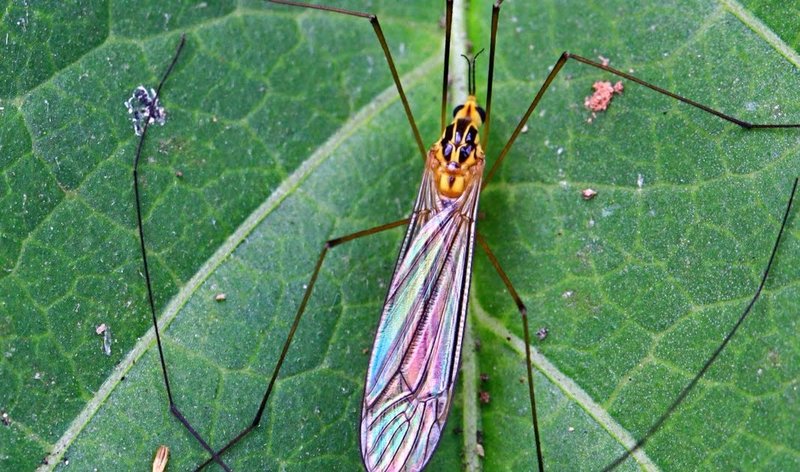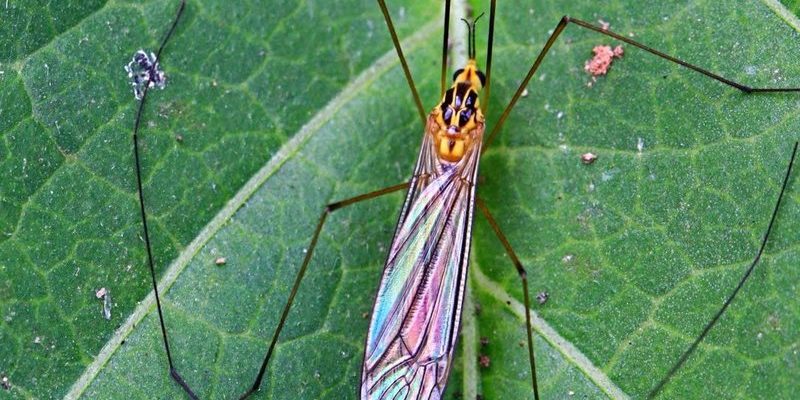
When you first encounter a crane fly, you might mistake it for a giant mosquito, but don’t worry—they’re harmless! These fascinating insects belong to the family Tipulidae and are often found fluttering around in gardens, fields, and even near water sources. With their long legs and delicate wings, crane flies can look a bit clumsy as they hover near lights at night. However, their unique appearance and behavior make them truly interesting creatures to observe.
Crane flies thrive in various habitats, from temperate forests to wetlands. They play a vital role in the ecosystem, providing food for birds and other wildlife. Despite their size and delicate nature, they are quite resilient and can be found in many environments worldwide. So, let’s dive deeper into what makes crane flies so intriguing.
Characteristics of Crane Flies
Crane flies have a distinct appearance that sets them apart from other insects. Most species have elongated bodies ranging from 1 to 2 inches in length, complemented by a set of long, spindly legs that can be several times longer than their bodies. Their long wings are usually transparent and can span up to 4 inches, giving them a graceful look as they fly.
One of the standout features of crane flies is their legs. While it might seem like they could easily get tangled up, these long legs help them move quickly and evade predators. When they feel threatened, crane flies can even shed a leg to escape—a fascinating survival tactic!
Crane flies come in various colors, including shades of brown, yellow, and gray. Some species even have tiny markings on their wings, which can make them look quite artistic. Overall, their unique looks and slight movements make them interesting subjects for observation.
Life Cycle of a Crane Fly
Understanding the life cycle of a crane fly is like taking a journey through an exciting adventure. It starts with the female laying hundreds of eggs in moist soil, which hatch into larvae known as ‘leatherjackets.’ These larvae are quite different from their adult counterparts. They have stout, cylindrical bodies and are primarily found in damp areas, where they feed on decaying plant matter.
As the larvae mature, they may take several months to develop, depending on the environmental conditions. After this stage, they pupate, entering a cocoon-like stage where they undergo metamorphosis. This process can take a few weeks. Once the transformation is complete, the adult crane fly emerges, ready to take on the world—albeit briefly, as most adults only live for a few weeks.
The adult stage is primarily about reproduction. Once they mate, the cycle starts over with females laying more eggs, continuing this fascinating life cycle. It’s amazing how much action happens in such a short period, don’t you think?
Habitat and Distribution
Crane flies can be found in many habitats around the globe. They prefer regions with high humidity, which is why you’ll often see them near rivers, ponds, or during rainy seasons. These insects thrive in places where organic matter is abundant, providing essential nutrients for their larvae.
While you can find crane flies almost everywhere, they tend to be particularly abundant in temperate regions. From the lush forests of North America to the wetlands of Europe, crane flies are adaptable and can quickly colonize areas that meet their moisture needs. Their ability to thrive in diverse environments makes them a fascinating study for entomologists and nature enthusiasts alike.
It’s interesting to note that crane flies are often more visible in late summer and early fall when they emerge from their larvae stage. If you’re out in nature during these times, keep your eyes peeled. You might just see some of these graceful insects fluttering about!
Diet of Crane Flies
As a crane fly moves through its life stages, its diet differs significantly. The larvae, or leatherjackets, primarily feed on decaying organic matter in the soil, playing a crucial role in nutrient recycling. They help break down dead plants, which enriches the soil and promotes healthy plant growth. In this way, they contribute positively to their ecosystem.
On the other hand, adult crane flies don’t eat much. In fact, many don’t even feed at all! Instead, they rely on the energy stored in their bodies from their time as larvae. Some species may sip on nectar from flowers or feed on moisture from damp surfaces, but this is less common.
This limited feeding habit is why adult crane flies have a shorter lifespan. They don’t need to spend energy searching for food, as their main goal during this time is reproduction. It’s quite a fascinating contrast between the voracious larvae and the more laid-back adults!
Predators of Crane Flies
Despite their somewhat awkward appearance, crane flies have a few natural predators that keep their population in check. Birds, for instance, are among the primary hunters of these insects. Species like swallows and sparrows often swoop down to catch crane flies mid-flight, making them a target during their evening activities.
Other insects, including dragonflies and spiders, are also known to prey on crane flies. Their long legs might help them avoid some attacks, but when caught by these agile hunters, it’s game over for the crane fly. It’s all part of nature’s balance, right?
Interestingly, because crane flies are not a significant food source for many animals, they tend to thrive in environments with fewer predators. This adaptability allows them to flourish in diverse ecosystems while still being mindful of where they land—after all, something might be lurking nearby!
Interesting Facts About Crane Flies
Crane flies may seem simple at first glance, but there’s so much more to these insects than meets the eye. For instance, did you know that some crane fly species can live up to a year in their larval stage? This long development period allows them to grow large and strong before they emerge as adults.
Another fun fact is that crane flies are often mistaken for mosquitoes, but they don’t bite or sting, so there’s no need to worry about an itchy encounter! In fact, they are harmless and primarily serve as food for other creatures in the food chain. Isn’t it refreshing to learn that not every insect poses a threat?
Lastly, crane flies come in many varieties, with over 15,000 species identified worldwide! Each species has its unique traits contributing to its appeal. Whether you’re an amateur insect enthusiast or a seasoned biomonitor, these diverse insects can spark curiosity and wonder.
Crane flies are fascinating insects that challenge our perceptions of the insect world. With their graceful appearance, unique life cycle, and fascinating adaptations, they play an important role in their ecosystems. Whether you encounter them fluttering around your porch light or hidden in a wetland, take a moment to appreciate these wonderful creatures.
So, the next time you see a crane fly, remember that there’s more to it than just a long-legged insect. They are part of a complex web of life, contributing to the environment in ways that might surprise you. Keep exploring and learning about the wonders of the natural world—you never know what you might discover next!
FAQ
Can crane flies bite or sting?
No, crane flies do not bite or sting. They are harmless insects that primarily feed on nectar or rely on the energy stored from their larval stage. You can observe them without worrying about getting bitten.
How long do crane flies live?
Adult crane flies typically have a short lifespan, often ranging from a few days to a few weeks. This is because their main focus is on reproduction. In contrast, their larvae can last for several months to over a year, depending on environmental conditions.
Where do crane flies lay their eggs?
Female crane flies lay their eggs in moist soil, often in areas close to water sources. The eggs hatch into larvae, known as leatherjackets, which thrive in the damp ground and feed on organic matter.
What do crane fly larvae look like?
Crane fly larvae, also known as leatherjackets, have stout, cylindrical bodies that can vary in color from brown to green. They are typically about 1 inch long and have a somewhat wrinkled appearance, which helps them blend into their surroundings.
Are crane flies beneficial to the environment?
Yes! Crane flies play an important role in their ecosystems. The larvae help decompose organic matter, enriching the soil and promoting plant growth. Additionally, they serve as a food source for various birds and other predators.
Can I find crane flies in my garden?
Absolutely! Crane flies can often be found in gardens, especially in moist areas where decaying plant matter is present. If you notice them hovering around at dusk or near lights, it’s a good sign that your garden might be a suitable habitat for these fascinating insects.
How many species of crane flies are there?
There are over 15,000 identified species of crane flies worldwide. They come in various shapes, sizes, and colors, making them a diverse family of insects that can be found in many different environments.
How can I attract crane flies to my yard?
To attract crane flies, create a garden with plenty of moisture and organic matter. Incorporating plants that provide shelter and ideal conditions for larvae to thrive can help invite these intriguing insects to your space.
Do crane flies have any predators?
Yes, crane flies have natural predators, including birds like swallows and sparrows, as well as insects such as dragonflies and spiders. Their long legs may help them evade some predators, but they remain an essential food source in the ecosystem.
What time of year are crane flies most active?
Crane flies are usually most active during late summer and early fall when the adults emerge from their pupal stage. This is when you’re likely to see them fluttering around in gardens or near light sources.
What is the main difference between crane flies and mosquitoes?
The main difference between crane flies and mosquitoes is that crane flies do not bite or sting. While they may look similar in size and shape, crane flies are harmless and primarily serve as food for other animals.
Can crane flies be found in all regions?
While crane flies are widespread, they are most commonly found in temperate regions. They thrive in habitats with high humidity, so you may notice more of them near rivers, ponds, or during rainy seasons.

